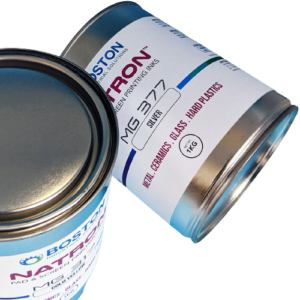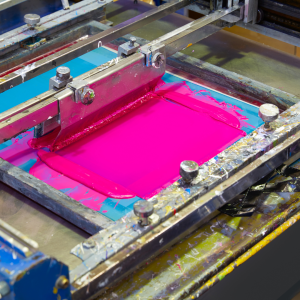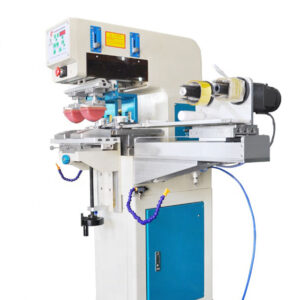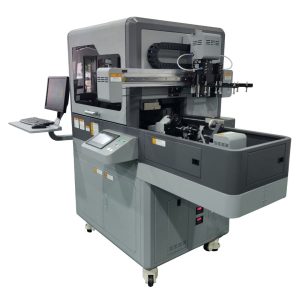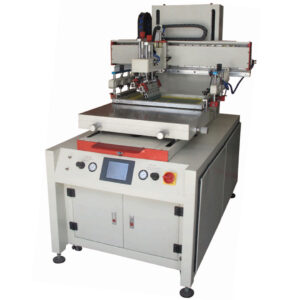Digital printing involves directly transferring digital images or designs onto a substrate. Examples of substrates include paper, fabric, stone, metal, plastics, wood, and more. While there are many applications for digital printing, our focus will be on direct-to-object printing. Digital printing uses digital files to print and control the printing process. This is unlike pad printing or screen printing, which require pad printing plates or screens for printing.
To print, digital artwork (raster images or bitmapped images) is sent directly from the computer to the digital printing press. The digital printer then prints directly on the substrate. Examples of digital printing presses include UV printers, digital cylinder printers, UV flatbed printers, etc.
Digital printing vs. screen and pad printing
Pad printing and screen printing are popular object printing methods.
Definition of pad printing: an indirect offset (gravure) printing process where a silicon printing pad takes a 2-D image from a laser-engraved (etched) printing plate (also called cliché) and transfers it to a 3-D object. Synonyms of pad printing are tampography or tampo printing.
Definition of screen printing: a process of transferring an image onto a substrate by printing ink through a mesh screen. Synonyms of screen printing are serigraphy and silk-screen printing.

Digital printing differs from traditional analog printing methods because it does not require printing plates or stencils to transfer an image; digital printing presses print the image directly onto the substrate in full color. For screen and pad printing, full-color printing requires artwork color separation and process colors. Each color requires a separate printing plate (cliché) or screen mesh. Inkjet printing, on the other hand, uses print heads that have nozzles. These nozzels jet inkjet ink onto the substrate. Other major differences when printing single-color prints include speed and crispness. Screen printing and pad printing produce very crisp prints and are capable of printing at a very high speed. Digital printing is quickly catching up. While it is yet to deliver vivid prints at high speeds, technological advancements are quickly catching up to the traditional analog printing methods. Some of the major advantages of digital printing include:
- Variable data printing—this is not possible with screen and pad printing. While it could possibly be done with screen and pad printing, it is very costly. Each new set of data would require separate artwork, plates, and set-up time.
- On-demand printing,
- cost-effective short runs,especially for full color printing
- Quick turnarounds,
- Full-color printing capabilities
Advantages and disadvantages of Inkjet printing
UV inkjet printing is excellent for on-demand, full-color runs that can be completed quickly and cost-effectively. This direct-to-object printing method also excels at personalization. Artwork modification is easy, as is using variable data printing (VDP), making inkjet printing the best way to print. With advancements in print quality and speed, industrial UV printers are quickly becoming a staple in the promotional printing industry as well as industrial printing. Printing on cylinders and conical objects was challenging for digital printing. But not anymore. With an excellent digital cylinder printer such as the Volta Gyra, it is now possible to print full color on demand at high speed. A major drawback of digital printing is the ability to print on odd-shaped objects; these types of applications are best handled by pad printing. Unfortunately, UV inkjet printers are more costly to run and maintain compared to pad or screen printing.
UV Ink for Digital Printing Equipment
There are three types of UV inkjet ink available: hard, flexible, and neutral. Each of these types of ink includes cyan, magenta, yellow, black, and white (CMYKW) UV ink. Additionally, there are extended color gamut UV printer inks such as light cyan and light magenta. Recently, manufacturers have started adding colors such as red, gray, and varnish with the intention of producing a full color gamut and enhancing prints.
Like screen and pad printing inks, UV inks do not adhere to low-sufficient-energy substrates such as polypropylene, glass, stainless steel, EVA, and coated metals. To overcome these adhesion challenges, use UV ink adhesion promoters such as the Natron Polypropylene primer, G1 Adhesion Promoter for glass, or the M74F stainless steel primer. Learn more about our Natron UV inkjet primers.


